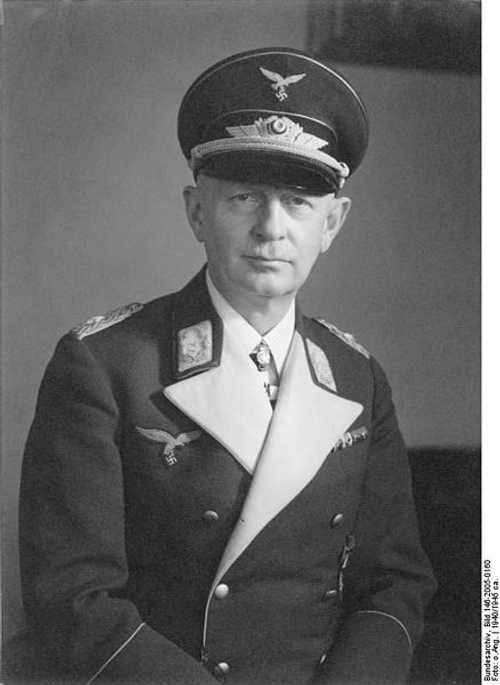
German Forces
The Very Model of an Occupation General.
Bundesarchiv
Generalleutnant Heinrich Niehoff, formal studio portrait, probably mid-1944. As far as one can tell (because his career does not seem to have been at all well-documented), Niehoff enjoyed a career of quiet distinction without ever really setting the world on fire. He was already an experienced professional soldier at the outbreak of WW1, and had a pretty "good war", spending most of the early part of it as a combat officer with 2nd Westphalian Infantry Regiment "Prince Friedrich of the Netherlands", and much of the latter part in Staff positions. In the former capacity (presumably), he received a number of combat decorations, including the Iron Cross, First Class. Most, if not all, of his WW1 service was on the Eastern Front. Niehoff was discharged from the Army in September, 1919 with rank of Major, at which rank he then entered the Prussian Police Force (not an unusual move for discharged soldiers at this time). His police career prospered; Niehoff had attained the rank of Generalmajor of Polizei when, on 1 February, 1936, the translated to the Luftwaffe with that rank, presumably to employ his administrative and Staff skills in the organization of the fledgling air force. By 31 March, 1938, when he retired from the Luftwaffe, he had advanced to the rank of Generalleutnant. By mid-1940 (it is difficult to determine at what date) he had been called back to the colors, like many other retired officers at the time. However, also like many other retired officers of somewhat modest combat, but significant administrative attainments, he was never to receive a combat or front-line staff assignment. However - again, like many similarly accomplished officers - he was destined to occupy important commands in the German Occupation Forces, in his case, in France. His first appointment was as field administrative commander of the German occupation forces at Lille, making him a key German occupation commander in the "Occupied" Zone of France. He yielded up this command in late-1942, taking up command of Army Area Southern France. Both the Lille and southern France commands would have been pretty quiet affairs, at least up to the arrival of the western Allies in France in 1944. The South of France was - for reasons of terrain as much as anything else - heavily permeated by French Resistance groups of all sorts, and the arrival of the Allies (reinforced by appeals from General de Gaulle) brought thousands of Maquisards (who had up to now been pretty quiet on the whole) out into combat. In the extreme western part of Niehoff's command area, the Occupation forces could rely on at least some support from elements of the German frontline forces deployed there to deter Allied invasion initiatives. In the eastern areas, frontline units were in very thin supply, leaving it to Niehoff and his subordinates to put down the Resistance threat to German lines of supply (and retreat) posed by the large-scale Resistance forces taking the field. At their disposal to do this were something of a hotch-potch of "reserve" units, of the general Heer; of the Schutzpolizei Special Reserve Police Battalions, of the Paratroops; and of the SD Security Police. It did not particularly help that the commanders of these various units did not always see eye-to-eye with each other. Nonetheless, it has to be said that many of the "Reserve" units involved had a strong record in anti-partisan warfare. Numerically, the total number of troops and police available came in at about 10,000 - 12,000. Consequently, the "highlight" of General Niehoff's command career came in the June-August, 1944 period, characterized in south-west France by a series of large-scale anti-Resistance operations. Niehoff was responsible for overall planning of these operations - but it is unclear how much planning was really involved, since the operations in question consisted of encirclement operations of a fairly standard sort anti-Partisan operation as developed in the Balkans and on the Eastern Front (albeit on a rather smaller scale than the larger Eastern Front operations of this sort). These operations were generally very successful - an outcome often advanced by obliging French Resistance armies that made the mistake of attempting to hold "mountain fortresses" like Vercors in conventional fashion, for which they lacked the tactical sophistication, numbers and heavy weapons. One thing that these operations did have in common with their Eastern Front equivalents was the ruthlessness displayed by the Germans in their conduct; the Sipo/SD policemen frequently practiced torture on useful-looking prisoners, and "collective punishment" of civilians was commonplace. Generalleutnant Niehoff might have found himself before a war crimes court for all this, even if his direct role remains, to this day, very unclear. Be that as it may, he finally retired from the Forces on 10 August, 1944, and returned to Germany. After the end of the war, he was arrested by the Russians in Berlin, and died in Soviet captivity in February, 1946. By the way - the General is wearing the Social Welfare Medal (replacement of the earlier Red Cross Medal) First Class - the Cross can just be seen at his throat. In practice, this decoration in its various grades was awarded to officials in recognition of their contribution to public services - a general civil and public service award in effect. Niehoff most probably received this in connection with his long Police service. Best regards, JR. Best regards, JR.
2962 Views
6/23/2015
